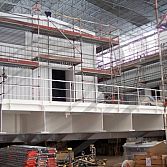A Simple Guide On Soundproofing A Studio Recording Room
Suppose you never visit any studio recording room. In that case, we will never realize how noisy the world is… all world noises that we never noticed may become painful when heard through a very high-quality condenser microphone.
The soundproofing a studio recording room is significant to get a great quality audio recording without any external noise. This also works for keeping your voice in and avoid any disturbance to your neighbours.
Now the central question in your mind is how to soundproof a studio recording room? Here are some methods of soundproofing and some practical advice on how to use them;
- For soundproof studio recording, the doors need to be a little heavy and airtight.
- As sound waves travel through solid material very well so we can use isolation strips for better results.
- Many mineral pieces of wool are used as stuffing into the air gap & acoustic sealants like glue, foam, & others for filling the small inappropriate gaps. One more material that is mostly used for filling tiny gaps is frame or mastic sealer.
- For studio recording windows, we can use a double or triple glazing window, but it must be airtight.
- Adding Mass
This is the most common method used for soundproofing. In this method, we increase the amount of material in the room boundaries to attain perfect soundproofing. This will make your room wall thicker &denser, so room wall not easily be vibrated by a wave of sound. When sound hits thicker barriers, it may be absorbed into the added mass or reflected, or both. Here is some mass you can use to your studio room surface for a better quality of soundproofing:
- Build a thicker or dense wall just like drywall which can absorb more sound waves.
- Apply denser wall padding by installing some absorbent panels or thick foam mats that help in soften noise within the studio room and will absorb noise from the outside.
- Use Acoustical glue or studio acoustic doors; these are specially designed doors and glue for soundproofing the studio recording room. Acoustical glue is also known as acoustic caulk glue which is designed as an elastic sealant that can be used with wall frames & installing drywalls. The material used for studio acoustic doors hold sound waves and absorbs it.
- Seal gaps with the appropriate-size of foam gaskets. There are several foam fillers which are cheaper but can also choose them with some additional insulation properties before finishing them to increase vibration absorbency.
- Use isolation foam pads that are used to put under speakers or equipment that generally produce vibration. The isolation pads generally absorb vibrations that produce from very high-frequency speakers.
- Decoupling structures & equipment by doing this you can isolate or eliminate unnecessary shaking that is the main reason for noise & buzzing sound.
- Lastly,you can install a specific door sweep which is a horizontal pillow-like structure that can be very easily slid under the door or you can also use a more professional looking door sweep for automatic gap fills with rubber.
- Acoustic Enclosure
Acoustic Enclosures are one of the best & specially designed solutions for controlling the high level of noise by muffling the very high level of noise from a DJ or other large size of equipment. For soundproofing, acoustic enclosures performs functions of absorption & insulation of sound wave.
In some cases of noise, it is a universal issue or problem. No one can make any thought or productive action in the presence of irritating noise or distracting voice, just like recording studios that need a sanctuary of peace to work.
Reactions
Be the first to write a review.
A large number of industrial appliances and machinery make quite a bit of noise because of moving parts such as rotors, vibrating panels, gears, engines, fans, belts, and more. Noise has increasingly
Read more
02-02-2021 - Things You Should Know About Acoustic Enclosures And Ground
In an airport, noise control is principal. To secure the immediate environment from noise from aircraft engines' routine testing, a Ground Run-up Enclosure (GRE) is utilized to decrease the noise leve
Read more
Author
David ClarkeDavid is a professional writer and blogger who writes for varieties of online publications. His interests of writing are home improvement ideas, home decoration, modern furniture, noise cancellation and a lot more.

